The day I learnt to cast a rod and reel was the day I earned a spot aboard my Grandfather’s boat for my maiden reef-fishing extravaganza.
Ironically, casting was not a skill that was necessary, as we simply lowered snapper leads over the gunwale into the depths.
The tools of trade were simple: A 12” Alvey winch, firmly planted (and sometimes hose-clamped) to a four-foot-nothing solid cane or fibreglass telegraph pole which, incidentally, did not telegraph anything. In fact, if you did hook an adversary large enough to bend your rod, it usually resulted in a bust-off due to the star drag screwed up tight with multigrips!
Letting them run wasn’t the plan: Strike hard several times and if there was any extra weight, crank like hell and skull-drag them into the boat was the recipe.
This style of fishing still is one of the more popular forms of inshore angling. It’s an exciting and productive way to score a feed all year round.
I still love bottom bashing but I’ve moved with the times to light but powerful graphite rods.
Whenever you lower a bait into the depths, it becomes a real lucky dip.
Whether you drift for flathead, anchor on hard reef or simply throw the boat into neutral in a likely spot and just start fishing, you just never really know what could jump onto your bait next.
This is what excites us when fishing this way. Sure, we have some idea what we want to catch, or which species to target in the chosen location, but it is the surprise that keeps it fun.
For example, a friend was drifting for flathead in 40m and was ambushed by a school of albacore tuna.
My fondest lucky-dip memory was hooking a marlin on a cube of pilchard while fishing for morwong and snapper in 30m. The marlin leaped into the air and severed my line on touchdown.
The majority of bottom bashing on the NSW South Coast generally takes place in 40m to 60m of water, where you are likely to find broken reef, gravel and mud patches.
Areas like these are great for an exploratory drift where you could score snapper, morwong, nannygai and pigfish. Then, five minutes later in the drift you could pick up flathead, trevally and various sand-dwelling sharks.
Deploying the anchor on hook up can keep your vessel located in bite zone if you’re after a feed of tasty reef fish. You could use marine charts and your sounder to isolate a likely spot or if you don’t mind bagging a few flathead among the mix, proceed with your drift.
While short, stiff boat rods with Alvey winches and heavy monofilament line still have their place in this game, the majority of modern (and old-school) anglers have made the swing to braided line.
Near-zero stretch from braid enhances bite detection and because of braid’s fine diameter, you need less weight to carry offerings to the seabed.
Thin line is less likely to be affected by current, reducing drag.
The current catches heavy mono and lifts your sinker from the bottom. The more line you release in attempt to stay connected with the bottom, the bigger the bow in your line, creating even more drag.
This also makes it more difficult to detect bites even when your bait does spend time in the bite zone.
Try to use the lightest, thinnest line that you are comfortable with and just enough weight to hold your bait on the bottom.
The beauty of using a lighter weight is we get to use lighter rods. Due to the lack of stretch in braid, we need rods with some give to act as shock absorbers to prevent pulling hooks.
Breaking with the tradition of short tree-stump rods, I opt for a rod at least 7’. Soft-tip glass rods or slow- to medium-taper graphite sticks rated from 6kg to 10kg will do the job nicely.
With thin braid, you are able to reduce the size of your reel, too. A 4000-size spin reel can comfortably accommodate 300m of 6kg braid, which is all that’s needed in this game.
Quality small threadlines are pulling some serious drag these days and are tough enough to crank big fish from the depths.
The best and most popular rig for bottom bashing is the simple dropper or paternoster rig. You can find this rig in all good knot books, or on Youtube.
Tie the paternoster or dropper with monofilament around 10kg to 15kg; it will be less visible to the fish, have more abrasion resistance and will be more pliable and easier to tie.
If you aren’t knot-savvy, you could always use the pre-tied rigs which you can purchase from your local tackle store.
Mustad, Black Magic and other makers have various sizes to accommodate your needs.
Some rigs contain hooks dressed with synthetic fibres looking similar to a saltwater fly. I particularly like this style of rig, because the fibres continue working for you if your baits are stolen.
When the bite is hot, you need not bait this style of rig at all, just simply jig the rig up off the bottom with short, sharp rod lifts similar to jigging with soft plastics or metals.
Bait can be anything at times because few bottom feeders are fussy. They will eat a sun-baked prawn as quickly as a beautifully presented fresh squid.
The important thing is to match the hook to the size of the bait you intend to use.
I like to use frozen pilchards. Cut into three pieces, they are just right for the 3/0 hook that seems to be the right size for practically all the species likely to be encountered.
I prefer the octopus pattern like the Mustad Big Red or a pattern with a hint of a circle to it, the Big gun. For a good circle hook that sits in the fish’s jaw without the necessity to strike, try the Demon Light Gauge.
A cut pillie is a great size bait for just about everything that swims and it’s just so convenient to grab a block of frozen pilchards from the tackle store rather than have to struggle sometimes to obtain fresh bait.
Facts
WEIGHING THE ALTERNATIVES
Instead of a snapper weight, try a metal jig.
A correctly weighted metal knife jig or Octa-style slow jig can add another chance of a hook up. If you miss a bite and believe your bait has gone, the jig may be enough to entice the fish to have another crack, resulting in boating the one that could have got away.
You also might be able to trigger a strike from a bottom fish, or even a passing pelagic, as you quickly retrieve your rig to bait up again.
Facts
21ST CENTURY BOTTOM-BASHING KIT
| • | 7’6” graphite or solid-tip rod, 5kg-8kg class |
|---|---|
| • | 4000 size threadline |
| • | 15lb braid |
| • | 2m lengths of 10kg-15kg mono for dropper leaders |
| • | 3/0 Octopus or circle pattern hooks |
| • | Alternatively, Mustad or Black Magic pre-tied rigs, 3/0 |
| • | Snapper weights from 15g to 150g |
| • | Alternative weights such as Lucanus/Octa jig or knife jig |
| • | Frozen pilchards and squid |
| • | Maybe even a 3” to 6” soft plastic grub, minnow or crawfish |

Danno refers to his Alvey winch as the ‘roulette wheel’. When using heavy mono line, you’ll need a hefty sinker. Check out the one on Danno’s lap.
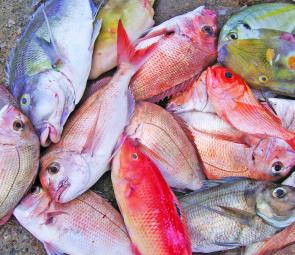
A typical mixed bag you can expect when bottom bashing on the South Coast – snapper, morwong, pigfish, nannygai, scarlet sea perch, trevally and leatherjacket. North of about Newcastle you can add pearl perch, sweetlip, tuskfish and more.

The author was stoked with his double header of snapper. The larger specimen ate a surf popper. Surf poppers bob around effectively at depth and need not be baited – convenient!
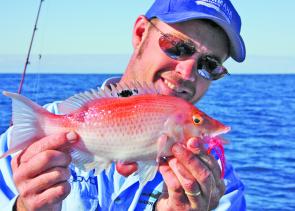
Pigfish are the South Coast’s answer to the tropical coral trout. A pink Mustad Flasher Rig did the job on this tasty item.
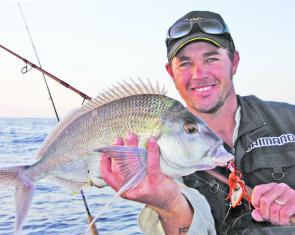
By replacing the sinker with an Octa-style jig, the weight becomes as affective a fish-catcher as a baited hook.
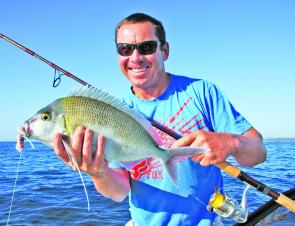
This hard fighting morwong took a liking to a blue Mustad Flasher Rig spiked with a slimy mackerel strip. Morwong generally make up the bulk of the bottom-basher’s catch.
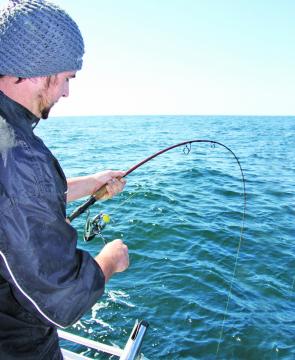
Modern light rods provide serious power. Spool up with low-drag braid and bottom-bashing becomes an enjoyable, lightweight affair.

You can expect anything while bottom bashing. Kyle Burnell was winding in to check his bait when this kingfish slammed his flasher rig on the way up.




